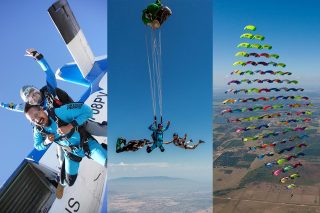The Language of Skydiving
Skydiving
Posted by: Skydive Perris
5 years ago
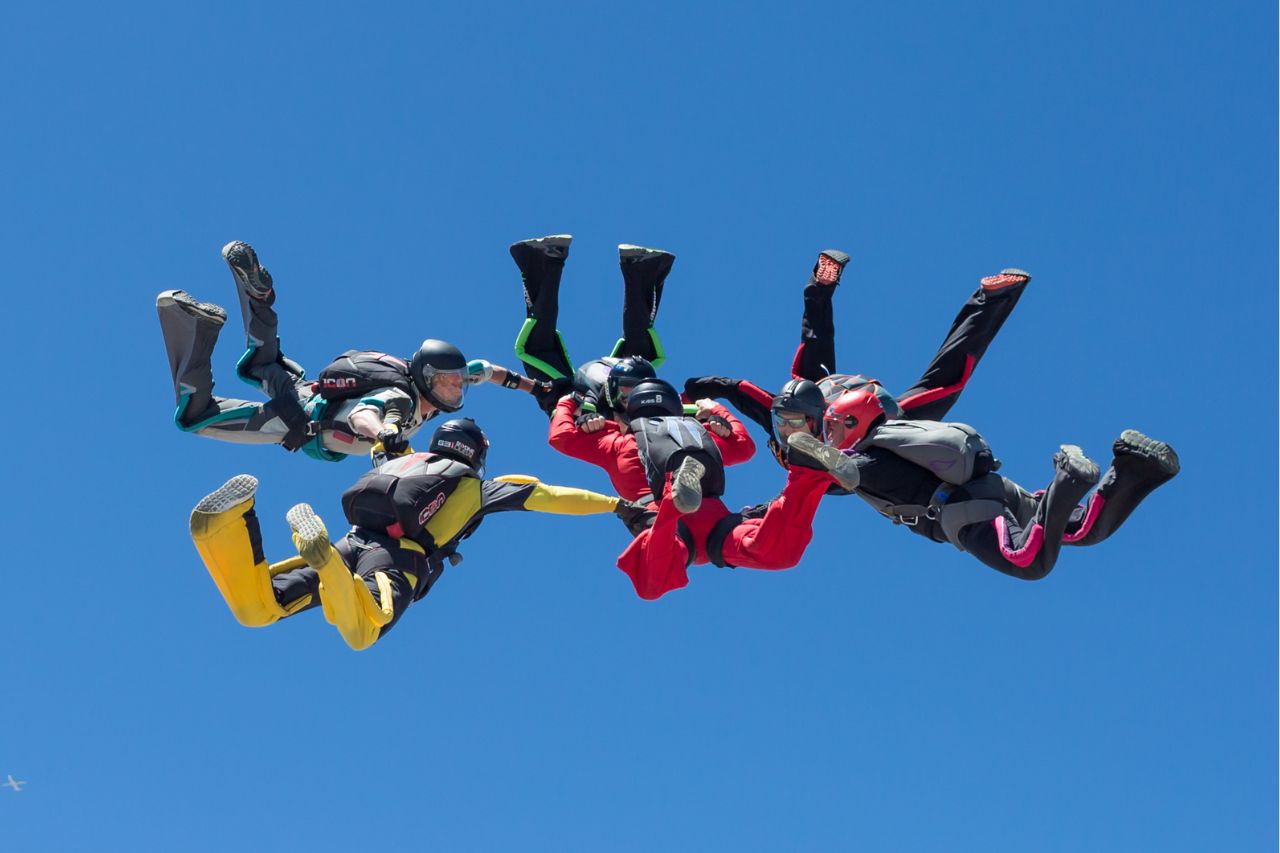
If you’re a newer skydiver, there’s a good chance you feel like you’re learning a new language. Are we right? Of course we are — and so are you, because there is a lot of terminology in skydiving that’s bound to be Greek to a newcomer. We’re here to help you get a foothold with this intro-level glossary to the words we use to communicate all things skydiving-related. Buckle up!
AAD
The acronym “AAD” stands for “Automatic Activation Device.” In short, the AAD is a device that’s designed to automatically deploy a skydiver’ if, for whatever reason, the skydiver is unable to do so him/herself. The deployment occurs at a predetermined altitude (usually between 750 and 1000 feet) if the small barometric computer senses that a main parachute hasn’t yet been deployed. Before every jump, we check each other to make sure that this magical little device is on and operational.
AAD technology, since its inception in the late 1980s, has saved thousands of skydivers’ lives. (You can see these for yourself on the websites of two major AAD manufacturers, CYPRES and Vigil.)
See also: CYPRES, Vigil
A-LICENSE
The USPA A-License is the introductory license you earn as the first step to becoming a skilled solo skydiver — and your official “golden ticket” to jumping solo (and with friends!) at skydiving dropzones around the world. This is the challenge of a lifetime, and it comes with its very own checklist: the A license proficiency card, which pings off a list of skills that you’ve gotta nail down before your AFF instructor signs off on your very first skydiving license.
AFF
Whaddaya know, y’all — another acronym! (Aviation loves an acronym, so it’s not surprising that there are so many of them in skydiving.) “AFF” stands for “Accelerated Free Fall,” and it’s the most common, most efficient training method in modern skydiving. It’s so good, in fact, that it has all but replaced previous skydiving instructioon methods: such as static line (SL) progression training or instructor-assisted deployment (IAD) training, where freefall only lasts a few short seconds.
AUDIBLE
Also called a “Dytter,” a skydiving audible is an audible altimeter. It’s a small barometric device that fits into the side of a skydiver’s helmet. The device is pre-set by the jumper to alert her when certain predetermined altitudes have been reached, so she has an additional set of warnings to “break off” from skydiving buddies and deploy her parachute.
See also: Breakoff
BOC
As you may have guessed by now, “BOC” is also an acronym. This one stands for “Bottom of Container.” It refers to the pocket that hugs the pre-deployment pilot chute to the bottom of the rig. The reason it specifically indicates the pilot chute’s position is that, despite the fact that nearly all modern rigs position the pilot chute this way, that wasn’t always the case. There was a time when pilot chutes were positioned elsewhere — for exmaple, on the belly, or along the leg strap.
BSR
We’re all about safety, in skydiving, and we have hardcore standards to uphold it. “BSR” is an acronym that stands for “Basic Safety Requirement.” The “BSRs” are the Basic Safety Requirements set forth by the USPA (United States Parachute Association). All USPA member dropzones (like us here at Perris) are required to follow these minimum safety standards — and they do!
BURBLE
A burble is the pocket of ‘dead air’ (or turbulence) downwind of an object traveling through the air. While skydiving, if you were in close proximity to another skydiver and flew directly over him/her, you’d feel suddenly unstable or a ‘drop’ having crossed into another jumper’s burble.
“Burble” is also the brand name of a software that dropzones sometimes use to manifest jumpers.
See also: Manifest
BOOGIE
A boogie is a skydiving party! A boogie event generally consists of special aircraft, highly talented, sought-after skydivers hired to put together special jumps, and various on-the-ground shenanigans. (Themed costume parties are a perennial boogie favorite.) Skydiving boogies have been around as long as the sport has been practiced for fun, and we’re proud to host some of the world’s best here at Skydive Perris. Check out the event calendar to see what’s next!
See also: Load Organizer
BREAKOFF
When you’re jumping with other people, you need to build a certain amount of time into the jump for everyone to go their separate ways at the end. This avoids canopy collisions and other dangerous close calls. We call this point in a skydive “breakoff”. Generally, it’ll occur between 1,500 and 2,000 feet above the deployment altitude.
CANOPY
Nope! It’s not a shade structure. It’s a parachute! Truth be told, we’re not entirely certain how this term came into use, but in the civilian world of skydiving (as opposed to the military), a parachute is generally referred to as a “canopy.”
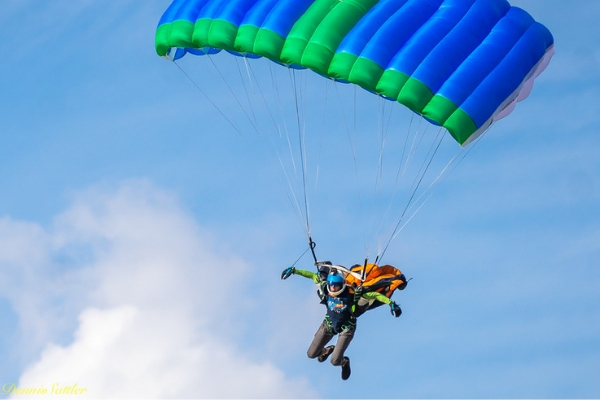
CONTAINER
We refer to the magical backpack that holds our skydiving equipment as a “container system”. (It’s also called a “harness container”.) We use the word “container” to differentiate the “backpack” part from the canopies that live inside it; all together, it’s called a “rig”.
CREEPER
This one’s a funny one, right? Don’t worry: If you see a creeper on a dropzone, you don’t call the police. You get right on it and roll around! A creeper is, in essence, a roughly person-shaped skateboard which a skydiver working in the RW discipline uses to simulate freefall maneuvers in a belly to earth position on a flat surface.
See also: RW
CRW
This acronym, pronounced “crew”, stands for the discipline of Canopy Relative Work. (Some folks refer to the discipline as “CF,” for “Canopy Formation”.) In this skydiving discipline, skydivers deploy their parachutes and then move close to each other in the sky, physically linking up with other skydivers and their parachutes as they fly.
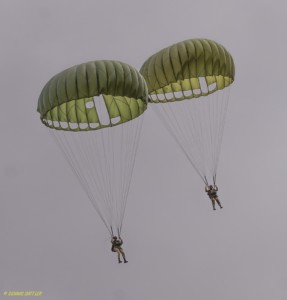
CYPRES
CYPRES is an automatic activation device (AAD), manufactured by the German company Airtec GMBH. The word CYPRES is in fact an acronym itself, standing for Cybernetic Parachute Release System.
See also: AAD
DEMO
“Demo” is short for “demonstration jump.” A demo is a skydive into a public place — generally in front of a cheering crowd, and often well away from the relative safety and reliable conditions of a normal skydiving dropzone. If you’ve seen someone skydive a flag into a sporting event, you’ve seen a demo jump.
DIRT DIVING
A great skydive requires rehearsal! That’s what “dirt diving” is all about. Because it takes place on the ground (and has skydivers walking around each other to simulate their positions in the sky), skydivers have cheekily given this rehearsal process its dusty moniker.
DZ
A “dropzone” is an official skydiving facility, of course, but you’ll rarely hear the word “dropzone” in conversation — you’ll hear this, its acronym. (Example: “Are you going to the DZ this weekend for the boogie?”) You’ll hear the acronym appended, occasionally, to point out a person: by “M,” to refer to the Dropzone Manager, and by “O,” to refer to the owner.
GRIPPER
How do you hold on to a friend when you’re both moving at terminal velocity? With a handle, of course! Grippers are soft fabric handholds built onto skydiving jumpsuits to make it easier to build the predetermined formation without slipping away.
HOT LOAD
Skydivers like it hot! A “hot load” refers to a skydiving aircraft that lands and immediately picks up the next group of jumpers, as opposed to shutting the engines down. It behaves like a taxi at a no-stopping-or-you-will-be-towed curb.
HOT FUEL
Bring on more heat! “Hot fueling” is the kind of thing that works for aircraft but doesn’t really work for your daily driver sedan: basically, the crew fuels the plane while the engines are still running. It’s a hot load plus fuel, with a slightly longer pause on the ground.
LOAD ORGANIZER
Also acronymed down to “LO,” a Load Organizer is a skilled skydiver who’s hired to put together skill- and conditions-matched skydives at big skydiving events and boogies. A great LO helps to keep a group of skydivers focused on fun, safety and skillbuilding — and to keep them cheerfully in the air all day long!
See also: Boogie
MANIFEST
Manifest is the heart of the DZ, in our humble opinions: the planning center that determines the dropzone’s operations for the day (and minute-by-minute). We use the word “manifest” to refer to both the office and the people that work there.
Manifest wears that moniker because the office generates a manifest for the aircraft that lists every person on every load. An efficient and skilled manifest is gold, because they’ll know how to best allocate organize tandem students and their instructors, AFF students and licensed skydivers in an orderly fashion on the airplanes that are available that day, keeping in mind aircraft efficiency, optimized wait times and the requirements of each of sport skydiving’s wildly different disciplines.
OFF LANDING
Whoops! Somebody landed off. Better send the truck…
An “off landing” refers to the more-than-occasional phenomenon of a skydiver realizing s/he is unable to land in the dropzone’s official landing area and making that landing somewhere in the outside world. (This is why we always jump with a charged phone. You just never know.)
JUMP RUN
The term “jump run” refers to the trajectory flown by the jump plane as the skydivers are exiting the aircraft. A skilled and experienced jump pilot will strategize a jump run to the given atmospheric conditions in order to correctly position skydivers over the airport.
PLF
Ah, the PLF: the “parachute landing fall.” Back when our parachutes were clunky round parachutes — not the fancy square, steerable and soft-landing designs we have today — a PLF was the only way to come down. Every skydiving student still learns to do it, because this particular skill distributes the shock from a bad landing along the body instead of concentrating it on one impact point. These days, a PLF is most useful when you’re landing in unfamiliar territory, accidentally downwind — or under any other circumstances in which you don’t feel very sure you’re going to come in for a tiptoe-perfect landing.
See also: Off Landing
PULL-UP CORD
Those ribbons you see everywhere around the dropzone have a special name, and this is it! Skydivers use pull-up cords to pull the closing loop through the grommets of a container, which allows a skydiver to more easily insert the closing pin through the closing loop. There’s really no other way to coax a the system to a secure closed position and get it ready for the next skydive. (Plenty of skydivers use them as shoelaces, too, so if you see ‘em in the real world you’ll know to strike up a conversation.)
See also: Container
RW
This acronym, which stands for “Relative Work,” refers to the O.G. skydiving discipline: falling belly-to-earth with your buddies and making beautiful, pre-determined, sometimes very complicated shapes in the sky. (It’s also called “belly jumping” and “FS,” for “Formation Skydiving,” depending on who you’re talking to.)
The most popular kind of competition skydiving is 4-Way FS. The largest number of people who succesfully built a formation like this was 400, in the skies over Thailand, in 1996.
See also: Gripper
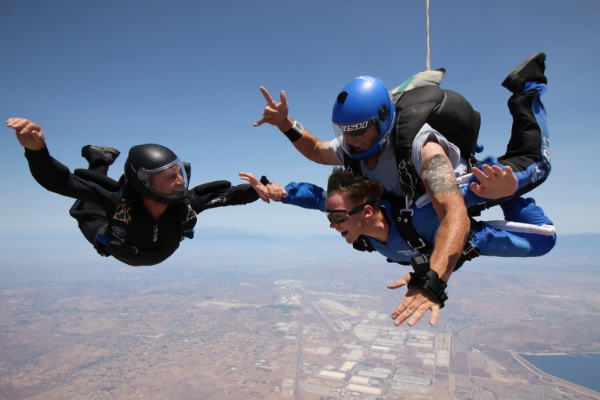
S&TA
The “S&TA” is the dropzone’s Safety and Training Advisor. It’s a very responsible position, generally held by an eminently experienced sport skydiver with a full complement of instructor ratings. Their job is to keep an eagle eye on the operation and make sure that the USPA’s BSR’s (Basic Safety Requirements) are being observed.
See also: BSR
SHUTDOWN
This, the opposite of a “hot load,” refers to the (very normal) situation in which a skydiving aircraft lands and shuts down its engines before picking up the next load of skydivers.
See also: Hot Load
SIM
When you learn to skydive, you spend a lot of time reading the SIM: the Skydiver’s Information Manual. Published (and continually updated) by the United States Parachute Association, the SIM is the comprehensive training and procedural manual for our sport.
SWOOPING
Some skydivers choose to focus their skydiving careers on flying their canopies. CRW practitioners do it in the air: Swoopers do it close to the ground. Swoopers do just that: they perform an aggressive landing technique (usually generated from a sharp, spiraling turn a comparatively short distance from the ground) in order to come in for a long, fast, “swoopy” landing over water or ground.
See also: CRW
THE PEAS
“The peas” are the traditional accuracy target for skydivers. These vary, but they’re generally a couple of meters wide. The term refers to the pea gravel generally used to full the space. Making a landing in “the peas,” especially if you’re dropping down fast for a super-accurate one, is softer than landing on the ground around them.
UPPERS
The “uppers” are the winds at higher altitudes. Often, they’re considerably stronger than ground winds, and they have the potential to push unaware jumpers off course and cause an off landing. Most dropzones (like ours) will post the uppers for jumpers to review before getting on the plane, so as to have a plan for exit that takes them into account.
See also: Off Landing
VIGIL
Vigil is, like the CYPRES, an automatic activation device. The Vigil is manufactured by Advanced Aerospace Designs.
See also: AAD, CYPRES
VFS
Vertical Formation Skydiving is a skydiving discipline which involves a group of skydivers executing a predetermined sequence of linked moves during freefall while moving through a sequence of body positions that are not belly-to-earth. VFS jumpers can fly sitting, standing, on their heads or on their sides.
See also: RW
WINGSUITING
The internet’s favorite kind of skydiving, it appears, is wingsuiting. This skydiving discipline involves wearing that iconic “flying squirrel suit” to move greater horizontal distances across the sky. Wingsuiting skydivers fly solo, in formations, and even linked with canopy pilots (in the relatively new XRW discipline). Fun fact: We have one of the most famous wingsuit schools in the world here at Perris: Lightning Flight.
Ready to learn to skydive and join the community? Find out how here!
Categories:
You May Be Interested In:
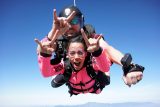
Unique California Experience Gifts for the Holidays
1 month ago by Skydive Perris

Skydiving Patches You Can Collect at Skydive Perris
3 months ago by Skydive Perris
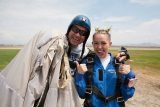
Famous People Who’ve Jumped at Skydive Perris
3 months ago by Skydive Perris
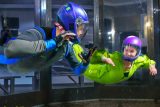
The Ultimate Family Hidden Gem in SoCal
6 months ago by Skydive Perris
